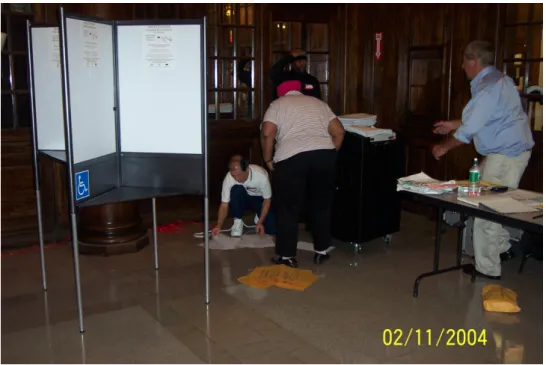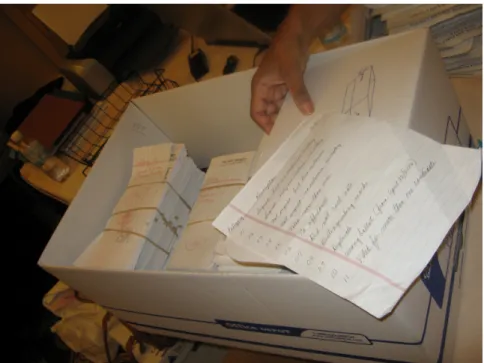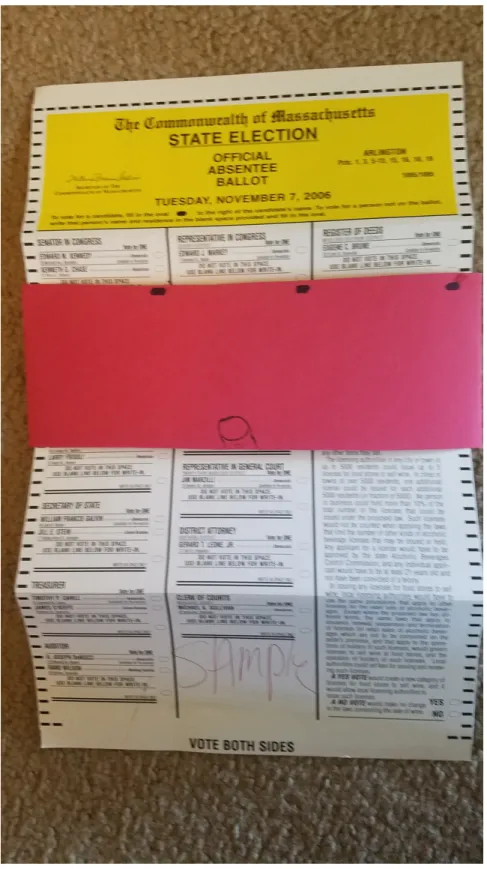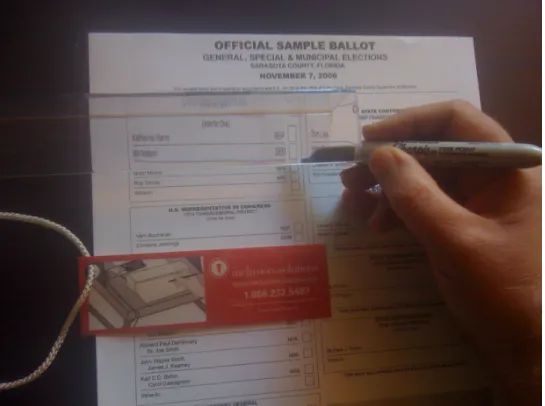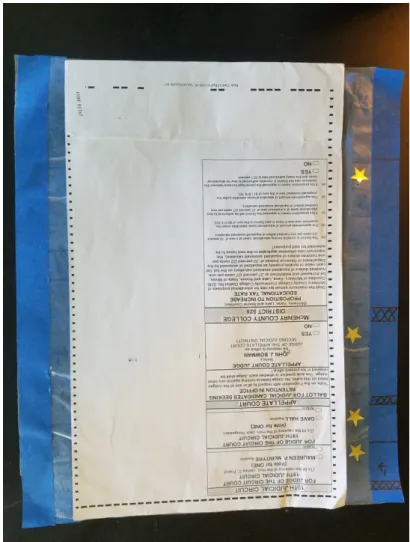HAL Id: hal-02908417
https://hal.archives-ouvertes.fr/hal-02908417
Preprint submitted on 29 Jul 2020
HAL is a multi-disciplinary open access
archive for the deposit and dissemination of
sci-entific research documents, whether they are
pub-lished or not. The documents may come from
teaching and research institutions in France or
abroad, or from public or private research centers.
L’archive ouverte pluridisciplinaire HAL, est
destinée au dépôt et à la diffusion de documents
scientifiques de niveau recherche, publiés ou non,
émanant des établissements d’enseignement et de
recherche français ou étrangers, des laboratoires
publics ou privés.
Design ideas to improve the usability and security of
mail-in ballots
Ted Selker, Enka Blanchard
To cite this version:
Ted Selker, Enka Blanchard. Design ideas to improve the usability and security of mail-in ballots.
2020. �hal-02908417�
Design ideas to improve the usability and security of mail-in ballots
Ted Selker 1
Enka Blanchard 2
1 Selker Design Research2 Loria, Université de Lorraine
Abstract
Despite the renewed discussion on mail-in voting, there has been little evolution on ballot and protocol design for this specific set of protocol constraints. This paper describes multiple designs pertaining to ballots, envelopes and chain of custody, that seek to improve the usability, accuracy and security of mail-in ballots. Our proposals include stickers to show voters how many selections can be made and where, and foldable envelopes that allows a user to slide their ballot through a viewing area in an organised way. These proposals also address ways of reducing voting errors for people with reading disabilities, short term memory problems, or motor difficulties.
1
Introduction
With the CoViD-19 pandemic, the usual electoral procedures have been questioned, with elec-tions being postponed or cancelled — such as municipal elecelec-tions in France or parliamentary ones in Sri Lanka. Where the elections were maintained — such as in Serbia — the health impact has been severe [Pan20]. As it happens, the USA — with its coming presidential election in November 2020 — already has a system in place that could address the issues: mail-in ballots (also known as absentee ballots). Voting by mail, using paper ballots, has multiple advantages in terms of usability and voter safety, but also introduces security issues — which is why it has been decried for decades.
The last two decades of improvements over Direct Record Electronic (DRE) voting ma-chines1 have shown the importance of design, especially for voters with disabilities (such as visual impairments or tremors [Sel07]), who have a higher number of issues when voting. Al-though bad user interface design can mislead voters into not succeeding at casting a vote for a given race [SI06, ASI05], well-designed systems can reduce the error rate when compared to paper ballots[SHGS05]. Moreover, the availability of redundant systems (such as audio interfaces) can make them both more accessible to visually impaired voters, and guarantee the privacy of the latters.
Are there design improvements for paper ballots that could help voters cast votes as intended? Based on earlier studies, the hypothesis is that if paper ballots could learn from the structuring and feedback of DRE user experiences, they might also greatly reduce voting errors. Simple tricks such as lining up the votes with a ruler can improve the accuracy of voters, especially when used in conjunction with magnifiers2 [Coh05].
Mail-in voting might not be able to benefit directly from such solutions, as sending each person a structuring and magnifying voting prosthetic would increase the costs. However, this paper takes inspiration from such previous designs and introduces a variety of paper-ballot designs and accessories.
2
Observed issues
This section is devoted to an analysis of various issues observed in different mail-in ballot systems around the world. What follows is far from an exhaustive list, and also includes problems that target general paper ballot systems. This is as our goal here is to obtain a 1Just like mail-in ballots, DREs have been decried for the vulnerabilities they introduce, especially through
hacking, but those considerations are beyond the purview of this paper.
partial list of constraints to keep in mind, as improving certain aspects can create new issues. For example, improving security and accuracy often comes with a usability cost.
We finish the section with a list of objectives that we will then try to attain with the ideas in the following sections.
2.1
Accuracy and usability problems
Accuracy problems arise in at least two different contexts. First, the voters themselves might make mistakes when filling in their ballot. For example, when faced with long lists of candi-dates, about 0.4% of the vote supposed to go to top candidates end up for the other candidates just above or below them on the ballot [Sle03]. They might undervote, also miss a race alto-gether, or overvote, which can lead to their ballot being voided as they have not selected the correct number of candidates for a given race. This can be due to many reasons, but ballot design (and computer interface design) plays a large role, as was observed in the massive undervote in the Sarasota County, Florida, election3in 2004. Similarly, folds in paper ballots
can make individual races harder to discern, and could lead to both undervote and overvote. Election officials have often complained about folds fouling ballot feeding in counting machines and optical scanning devices. There has also been widespread concern of any selections that are close to a fold being misinterpreted. Figure 1 shows an election official sorting ballots that had been folded clogged a ballot box in Boston. This doesn’t only apply to simple voting systems where voters choose a single candidate, or a subset of candidates from a list. Instead, accuracy issues seem to be compounded in complex ballots4. Ballots where voters are asked to rank or rate candidates as they choose might seem especially complex. This can be due to lack of familiarity with a new system — but it might not be the only reason — and this argument is often used when debating complex voting systems.
Figure 1: Election official sorting ballots that had been folded clogged a ballot box in Boston. 3A version of ES&S’s ballot caused a famous case where 13% of voters missed voting for the second race
on the ballot: congressional race 13 in Sarasota, Florida. The race was "hidden" at the top of the second page just above a large headline indicating State races. A race for judge in another Florida county that had a similar "hiding" race had an undervote of more than 21%.
4Even in ballots with a single race, many factors can influence voter accuracy: priming effects, layout,
Those concerns are also amplified in the context of disabled voters, especially visually or cognitively impaired ones. Many solutions have been devised to improve polling place accessi-bility, with DREs offering audio controls and audits, or different low-tech solutions for paper ballots [EBG06], such as magnifying set-ups [SGA+14]. On that front, increased availability
of mail-in ballots has been seen as a mixed blessing by disability activists and security experts as well. Although it lowers the cost of voting for those with physical disabilities, DRE voting on personal computers or devices has not yet been perfected. Blind voters are entitled to vot-ing independently, and requirvot-ing assistance to fill mail-in ballots is not equal access relative to the the ADA law in the USA, and not acceptable to many blind voters [LA11, KMHU06]. The second context is during the counting of the ballots, where multiple recounts often disagree on the exact numbers. This can be due to new ballots being found5, errors when marking down the results or when announcing them, disagreements over whether certain bal-lots are spoiled6.To note, this applies both with Direct Electronic Recording voting machines (DRE) and with paper ballots. Even simple systems with multiple redundancies haven’t en-tirely eliminated those issues [EG14]7. Scanning ballots also affects this, as the proportion of residuals8in the USA typically varies by 0.5% between polling places where voters scan their
own ballots and facilities where ballots are centralised and scanned [ASI05, SI06].
2.2
Security problems
The second central set of issues with mail-in ballots lies in their security. Unlike polling places where the ballot custody is contained within a physical space, mail-in ballots present challenges to trusted chains of custody [BBH+17]. Having people vote from home exposes the system to two different kinds of risk. First, there is the risk that the wrong ballot or no ballot is sent to the voter. The ballot can be misprinted, delayed during transit or intercepted. These interceptions can lead to multiple negative consequences, most importantly breaching the integrity of the vote by changing the ballot, and breaching the privacy of the voter by finding how they voted. There are multiple ways to address this, and oversight in ballot printing and mailing are essential. Tracking systems through identifiable marks on the ballots or the envelopes could be useful, but this can also be used to breach voter privacy depending on how it’s used (especially if the people organising the vote are corruptible) [FO02]. These security and privacy issues are the most common arguments against mail-in ballots in political debates, even with scant evidence of large-scale mail-in ballot fraud [Vie20].
A second issue, also non-trivial, is the lack of privacy and risk of coercion within one’s home. If the ballot is sent to a home, some people can be tempted to commit voting fraud by voting for their a family member who is unwilling or unable to. The ability of household members to coerce each other into voting in a particular fashion has been a longstanding issue9, and while a polling place affords better privacy, coercion is still a possibility, Nursing 5The first author has personally witnessed a box of votes were found behind a door in a polling place and
had to be airlifted to Los Angeles to be counted in the middle of the night.
6This only concerns legitimate disagreements over potentially spoiled ballots, without breaching into the
problem of potential fraud in the counting rooms, such as voting officials reviewing ballots in private with access to writing instruments, as the first author witnessed in Wellesley and Arlington MA.
7The study cited analyses the French ballot system for presidential elections (in a comparative study with
local DREs). It is designed to be simple, with a single race, and instead of putting a check-mark for the candidate of their choice, voters take a piece of paper with the name of the candidate and insert it into an envelope (while in a privacy booth). They then have to sign the voter rolls as they insert the envelope in the ballot box. The multiple checks at each step also happen with the counting, with the name on each ballot being read out and checked by two different officials, under supervision of representatives from the different parties [Min20]. Despite those redundancies, errors still happen: the study found discrepancies between the number of votes cast and the number of signatures on voter rolls, averaging between 0.08% and 0.32% when using paper ballots, with errors reported in 9.7% of polling offices.
8Residual votes correspond to the proportion of overvotes and undervotes, which vary by state and
tech-nology used, and are often used to analyse effects of technological change.
9For an example from the early 20th century, the French communists’ reluctance to give women the right
to vote was linked to a fear that they would follow the will of their husband or priest at the polling station, which would add votes for conservative parties [HK81].
homes in the USA have also had a problem of supplying ballots that were filled out in similar fashion for large numbers of their residents with voter assistance [Fay05].
2.3
Goals
We can use and expand the terminology from [RBH+09] and apply it to the mail-in ballot problem. Discarding questions of verifiability, we focus on their three components of integrity, and add a first one, necessary for the others.
Printed and delivered correctly is the first compound step, and corresponds to making sure ballots are created and delivered correctly. This includes the correction of the following steps: laying out a ballot with appropriate candidates ; having it printed correctly ; having it delivered to the mailing agent with no loss ; having it addressed and then sent without being delayed or lost, either in transit or at delivery.
Cast as intended is the second step, and corresponds to making sure that the ballot that is sent indeed corresponds to the voter’s wish. In this context, it mostly depends on usability. Echoing the earlier issues, this means avoiding undervote and overvote by making sure that people vote exactly once for each race (or as many times as needed when having to select multiple candidates). It also means making sure that the voter chooses accurately, without the problems mentioned above. Finally, there should also be mechanisms to prevent voter coercion in their home — when that is possible.
Recorded as cast is the third step, and means that the ballots should arrive to the count-ing/polling office as they were cast. This might include packaging the ballot correctly, po-tentially with an authenticating seal — such as a signature — on an outside envelope, and ensuring that the envelope arrives to the counting office while preventing an adversary from intercepting and replacing, modifying or removing ballots while they are in transit. Although it is not directly implied by the principle, it should also not be possible to add ballots. More-over, if any tracking method is used to protect the ballots in transit, it should also make it as hard as possible to breach voter secrecy without at least controlling a major part of the voting and postal infrastructure. This objective concerns all the methods that have an effect while the ballot is in transit.
Counted as recorded is the fourth step, and ensures that the total as reported by the counting office is indeed the sum of all valid ballots. However, in various jurisdictions, many reasons can be used to throw out a ballot10. Moreover, as stated above, although the error margins are low, hand-counting is hardly devoid from errors in practice, even with triple-checks. Thus, this concerns all the auditing and tracking techniques that apply in said counting office to remove the possibility for this kind of error or fraud. As an additional consideration is the legitimacy of the system. Mail-in ballots have been the subjects of frequent political debates, and fears about the possibility of fraud could be as detrimental as actual fraud, by eliminating the possibility of decision-making and paralysing the political system [Fla20].
10In Figure 2 showing the rejection reasons from New Orleans, for example, ballots were thrown out due to
either of the following: being signed but not with a witness or notary; with only one witness and no notary; with two witnesses but not signed; not being signed at all; having voted more than once; having no affidavit; not casting a vote; having distinguishing marks; being a duplicate ballot; using the wrong ballot; or voting for more than one candidate. In this case, throwing out thousands of ballots without notary stamps for people displaced by Katrina seems problematic if not corrupt.
Figure 2: Rejected ballots from New Orleans, with the list of reasons for rejection.
3
Ideas
We here propose a large set of ideas that could be used, independently or in concert, to improve different aspects of mail-in voting. Not all ideas here need to be used together, but we choose to present multiple options as they could lead to improvements in paper ballots and serve further developments.
3.1
Envelope improvements
The envelopes themselves can become usability tools to help voters vote privately, navigate the mail-in ballot, and be more accurate while filling it. Here are three examples of how this could be done.
Focusing mechanisms. To help voters focus on a single race, a sliding ballot holder could be included, as shown on Figure 3, or could be made from the envelope itself.
As an alternative, part of the envelope could also be either transparent or removable, as is shown on Figure 5. This would be especially helpful when using a single race per fold — as proposed further down. To help visually impaired people, the transparent segment could be a Fresnel lens, as on Figure 4, but this complicates the printing and mailing processes and raises costs.
Figure 3: An example of sliding ballot holder. The voter makes it move along the ballot, and it helps align the races one by one to improve usability and reduce overvote and undervote. This might be especially helpful for people with reading disabilities, tremors, or sight problems.
Figure 4: An example of inexpensive pocket magnifier already proposed for polling places. Modesty panels. The closing folds of the envelope itself can be used to afford improvement to privacy, by partially concealing the area the voter is focusing on from people in the same room, as is shown on Figure 5.
Figure 5: An example of unfolding envelope. The top unfolds up to partially cover what the voter is looking at.
Sticking envelopes. The bottom of the envelope could be made of removable adhesive. In conjunction with the previous methods, this could increase stability, especially for voters with limited fine motor control.
3.2
Ballot improvements
One race per sheet. So as to reduce accuracy issues and make it simpler for voters, it seems natural to have a single race per sheet of paper. This can be done by having each separate race on a different card (recto only), making the mail-in ballot an envelope containing a stack of cards. It is also possible to fold a single sheet of paper – potentially with differently sized folds – with a single race per fold to reduce waste. However, it is likely that making each race the same length of paper in folds would be simpler and easier to handle.
Tabs. Indexing tabs on top of each card could help voters navigate the different races, as shown on Figure 6. Each card would have a protruding tab, with the summary of the race (like "Presidential" or "Sheriff") indicated on it. Depending on the number of races, there could be multiple layers of tabs. The tabs could also be on the side of the ballot instead of the top/bottom. This is compatible with folded ballots, but might not be easily adaptable to the ballot holder or scanner systems.
Figure 6: An example of indexing tabs.
Stickers. As a way to both control for overvoting and undervoting — and to make the mail-in ballot self-sufficient — adhesive stickers can be used. One option is to have a sheet of stickers distributed with the ballot (or integrated with the ballot, e.g. on the side margins), such that voters unpeel them one at a time, and then stick them in front of the candidate of their choice on the appropriate race. This allows the voter to see where and how many selections are available at all times. The stickers should be easy to peel off their initial sheet — a star-like shape for example, has more corners that can be easily peeled up than an oval
11— without being removable from the ballot without visibly damaging the paper.
11Although this creates something akin to gamification which could increase voter engagement, the fact
The stickers can be laid out on the corresponding tabs, as a memory aid. This way, voters can find out at a glance which races they have yet to vote on. An example of how to add this to an already existing ballot is shown on Figure 7. In this case, gutters on each side of the ballot include indications of where races begin and end with stickers associated with each. The gutters can be easily be designed to pull off as a sticker or tear off on perforations.
Figure 7: A ballot with added stickers on the side. The nonstick paper makes it easier to peel them out, and the indicators next to them allow voters to quickly check which races they haven’t voted on yet.
Another option would be to print the ballot on a two layer paper; with the top layer being a sticker that can be removed from the bottom layer. The ballot is printed so that each sticker is printed adjacent to the corresponding race, with as many stickers as allowed selections for that race. The voters peel one off for each race, and sticks it next to the candidate of their choice.
The voter can remove the gutters with unused stickers or put any unused sticker in a designated place at the end of the ballot to ensure that any undervote is intentional12.
Stickers can be made compatible with write-in candidates in multiple ways, the simplest corresponding to leaving two spaces: for the candidate’s name, and for the sticker next to it (to ensure that all stickers are used).
12This raises the possibility of voiding a ballot by adding more stickers at the end to show that it was
Ballot correction mechanisms. One common issue with mail-in ballots is that if it is possible to correct mistakes, then a ballot intercepted en route (or within the household) could be modified. On the other hand, if the decisions made are non-modifiable (for example with unpeelable stickers), any mistake requires the voter to void their ballot, and obtain a new one, which complexifies the ballot distribution process and might prevent certain people from voting due to the added cost.
One method is to provide the voter with multiple copies of the blank ballots while pre-venting them from voting twice. This can be done using tracking systems on the ballots, or a unique and identifiable return envelope, but could confuse voters.
A second method is to make ballots initially modifiable, but to add a way to make the ballot non-modifiable once the voter is satisfied. For example, a fully transparent adhesive sheet could be pasted onto the ballot to prevent further modifications, as is sometimes done on cheques with sellotape.
Finally, if stickers are used, a small number of duplicate stickers could be added in tandem with cover-up "undo" stickers that would void whatever sticker was underneath, allowing the voter to put a second sticker on that same race without it counting as an overvote. One approach to this, in the case of a ballot entirely printed on a sticker sheet, is to have a composite sticker that has a couple "undo" stickers within its perimeter; if one or more of these are used, the composite sticker will be missing those. The composite sticker is used to seal the ballot and reveal how many cover-up stickers were used before the ballot was sealed. This makes it clear that the voter put the undo stickers on while voting.
More usable ballots for visually impaired people. Braille ballots have been made available in certain places in the USA, but this is not a fully accessible solution, as only some 10% of visually impaired people have the ability to read it, and it could increase error rates in any case [NFB09].
This means that off-the-shelf applications on phones that can be used to scan the ballot and read aloud what is viewed by the camera could suffice to list the candidates in order (after which the voter could put a sticker on the corresponding dent). This scan could be made relatively secure thanks to multiple considerations: there are multiple potential applications that could be used, all of them could be audited continuously during the vote — including by friends of the voter to check that it works correctly before the vote happens. Changing the names or order of candidates would also require non-trivial modifications, as it would only be interesting to do so when certain geographical or political conditions are true (to give a party a statistical advantage).
Although reading in braille is not an option for most visually impaired voters, finding a few dents or cuts in the paper should be. By using appropriate markings for the sliding ballot holder, it should then be possible to only show one race at a time. Making an x cut in the ballot to indicate where to put the sticker could improve general usability, while keeping costs low as it could be naturally integrated in the sticker cutting phase. This x can be felt by the voter, and could improve security by making it harder to remove with tearing the paper.
3.3
Chain of custody improvements
Envelope tracking. Making sure that the envelope gets safely from the — legitimate — voter to the ballot box (or the polling office) is the first priority for the chain of custody for the marked ballots. The issue is of course doing that without breaching the voter’s privacy. Another option is to have two return envelopes one inside another. The first envelope bears the name of the voter and is signed by them. Once at the polling office, the officials receive that envelope, check that the voter hasn’t voted yet and is on the voter rolls, and then opens it before casting the envelope inside into the ballot box. This is sometimes already done, in one form or another, in certain voting systems, although not always with the security of a second envelope. Similar features can be implemented in a variety of ways.
To reassure voters that their ballot arrived safely, voters might apply at any point before the vote for a pair of linked scratch-off tickets with unique numbers. They scratch the same digit on both tickets to check that they are indeed identical, and then put one inside their envelope. When the envelopes arrive at the polling office, the ballots are cast in a ballot box, and the tickets in another, to decorrelate them. The tickets are then scratched and checked, and the numbers printed online (or shown at city hall). Inspired by systems already in place in countries like Portugal or Romania [UD15], the idea is to create an incentive for voters to use the system, by offering some lottery with the tickets (and a special prize if someone shows an inconsistency).
Identifiable ballots. One issue that regularly comes up in recounts is that each subsequent recount finds slightly different totals for each candidate. One method to improve the counting accuracy and eliminate potential avenues for fraud would be to make the ballots identifiable. Not when they are being filled (as it would break the privacy of the voter) but when they are first taken out of the ballot box. A numbering stamp would be enough for the purpose, and make errors easier to track during audits and recounts.
Attributable recounts. An extension of the post-vote identifiable ballot idea is for the person counting the ballots to also be identifiable, for example by having a specific numbering stamp (with a different pattern for each person). This could be useful in hand recounts or in jurisdictions where initial counting is done by hand. Although this could improve the security of the chain of evidence, it also makes it easier to find out who miscounted in which way, which could be used for disciplinary purposes by a powerful adversary in a sufficiently corrupt system.
4
Discussion
The ideas shown here are proposals that can be easily tested and implemented. They each need empirical studies to validate their usability and ease of production, as well as more thorough examination to see whether they might themselves cause confusion or errors. The current CoViD-19 pandemic makes this harder to organise, but at the same time, the potential massive deployment of mail-in voting in the intermediate future also makes those improve-ments all the more critical, as existing voting protocols might be too impractical not to make changes, even if change seems difficult. As voting officials are often a major part of practical experimentation on such procedures [BS18], we encourage anyone interested to communicate with the authors for any experimental engagements.
Acknowledgements. Both authors contributed equally to the different parts of this preprint. This work was supported partly by the French PIA project “Lorraine Université d’Excellence”, reference ANR-15-IDEX-04-LUE.
References
[ASI05] S. Ansolabehere and C. Stewart III, “Residual votes attributable to technology,” Journal of Politics, vol. 67, no. 2, pp. 365–389, 2005.
[BBH+17] M. Bernhard, J. Benaloh, J. A. Halderman, R. L. Rivest, P. Y. Ryan, P. B. Stark,
V. Teague, P. L. Vora, and D. S. Wallach, “Public evidence from secret ballots,” in International Joint Conference on Electronic Voting. Springer, 2017, pp. 84–109. [BS18] N. K. Blanchard and T. Selker, “Improving voting technology is hard: the
trust-legitimacy-participation loop and related problems,” in Workshop on Socio-Technical Aspects in Security and Trust – STAST, 2018.
[EBG06] S. P. Everett, M. D. Byrne, and K. K. Greene, “Measuring the usability of paper ballots: Efficiency, effectiveness, and satisfaction,” in Proceedings of the Human Factors and Er-gonomics Society Annual Meeting, vol. 50, no. 24. SAGE Publications Sage CA: Los Angeles, CA, 2006, pp. 2547–2551.
[EG14] C. Enguehard and J.-D. Graton, “Machines à voter et élections politiques en France: étude quantitative de la précision des bureaux de vote,” Cahiers Droit, Sciences & Tech-nologies, vol. 4, no. 4, pp. 159–198, 2014.
[Fay05] J. A. Fay, “Elderly electors go postal: Ensuring absentee ballot integrity for older voters,” Elder Law Journal, vol. 13, p. 453, 2005.
[Fla20] C. Flanders, “Was the 2016 election legitimate?” Saint Louis University Law Journal, vol. 64, no. 4, p. 7, 2020.
[FO02] J. C. Fortier and N. J. Ornstein, “The absentee ballot and the secret ballot: Challenges for election reform,” U. Mich. JL Reform, vol. 36, p. 483, 2002.
[HK81] S. C. Hause and A. R. Kenney, “The development of the catholic women’s suffrage move-ment in france, 1896-1922,” The Catholic historical review, vol. 67, no. 1, pp. 11–30, 1981.
[KMHU06] A. M. Keller, D. Mertz, J. L. Hall, and A. Urken, “Privacy issues in an electronic voting machine,” in Privacy and Technologies of Identity. Springer, 2006, pp. 313–334. [LA11] B. W. Leeber and J. L. Amato, “Improving voter privacy for the blind,” 2011.
[Min20] Ministère de l’Intérieur. Fonctionnement d’un bureau de vote. 2020. https://web.archive.org/web/20200625022510/https://www.interieur.gouv.fr/ Elections/Comment-voter/Fonctionnement-d-un-bureau-de-vote
[NFB09] NFB Jernigan Institute, “The Braille literacy crisis in America,” National Federation of the Blind, Tech. Rep., 2009.
[Pan20] M. Pantelic. What were the protests in serbia re-ally about? 2020. https://web.archive.org/web/20200722073658/https:// www.aljazeera.com/indepth/opinion/protests-serbia-200718175749533.html
[RBH+09] P. Y. A. Ryan, D. Bismark, J. Heather, S. Schneider, and Z. Xia, “Prêt à Voter: a voter-verifiable voting system,” IEEE transactions on information forensics and security, vol. 4, no. 4, pp. 662–673, 2009.
[Sel07] T. Selker, “The technology of access: Allowing people of age to vote for themselves,” McGeorge Law Review, vol. 38, pp. 1113–1136, 2007.
[SGA+14] T. Selker, D. Gillette, L. Avendano, S. Hoque, K. Liu, M. Pham, and M. Vroomen,
“Research in accessible voting report,” US Election Assistance Commission, Tech. Rep., 2014.
[SHGS05] T. Selker, M. Hockenberry, J. Goler, and S. Sullivan, “Orienting graphical user interfaces reduces errors: the low error voting interface,” Caltech/MIT Voting Technology Project, Tech. Rep., 2005.
[SI06] C. Stewart III, “Residual vote in the 2004 election,” Election Law Journal, vol. 5, no. 2, pp. 158–169, 2006.
[Sle03] S. M. Sled, “Vertical proximity effects in the California recall election,” Caltech/MIT Voting Technology Project, Tech. Rep., 2003.
[UD15] M. D. Ungureanu and D. Dascălu, “Tax lottery receipts in romania, a different approach to fight against tax evasion,” in International Conference on Economic Sciences and Business Administration, vol. 2, no. 1. Spiru Haret University, 2015, pp. 267–275. [Vie20] E. Viebeck. Minuscule number of potentially fraudulent ballots in
states with universal mail voting undercuts trump claims about election risks. 2020. https://web.archive.org/web/20200613121341/https: //www.washingtonpost.com/politics/minuscule-number-of-potentially-fraudulent- ballots-in-states-with-universal-mail-voting-undercuts-trump-claims-about-election-risks/2020/06/08/1e78aa26-a5c5-11ea-bb20-ebf0921f3bbd_story.html
